
Left click on image for large version

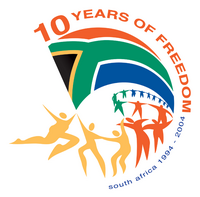
HartRAO Home > news > Celebrating Ten Years of Democracy 2004/06/30
To celebrate Ten Years of Democracy, a number of people from branches of national, provincial and local government were invited to the Observatory. The day began with a presentation by Mike Gaylard on what Ten Years of Democracy has let the Observatory achieve. The visitors then split into two groups to get a behind-the-scenes look at the observatory, and particularly to meet new staff and students, who will be the scientists, engineers and technologists of the future. This was followed by lunch on the lawn in front of the radio telescope. The day closed with a discussion led by Tessa Marcus of the National Reseasrch Foundation (NRF) on promoting interaction between science and government. The images below give an idea on what the visitors saw on their tour of the national facility.

For this group, the tour began in the new student laboratory for Space Geodesy. Here PhD student Attie Combrink, to the right of the display, is describing his research on using data from Global Positioning System (GPS) receivers across Southern Africa to measure the atmospheric water vapour content. On the left of the display is Sakia Madiseng, who has just finished describing his investigation into setting up a new Satellite Laser Ranging facility. Space Geodesy programme manager Ludwig Combrinck listens with interest on the far left.
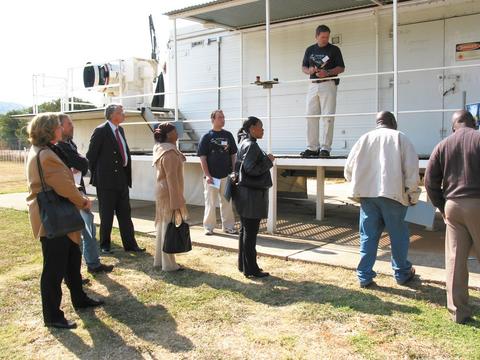
The Satellite Laser Ranger measured the orbits of various satellites with a precision of centimetres. Here SLR manager Wilhelm Haupt demonstrates how the retroreflectors on the satellites reflect the laser light pulses back in the direction from which they came. The laser ranger itself is seen on the upper left, behind NRF Deputy President Gerhard von Grunewaldt.
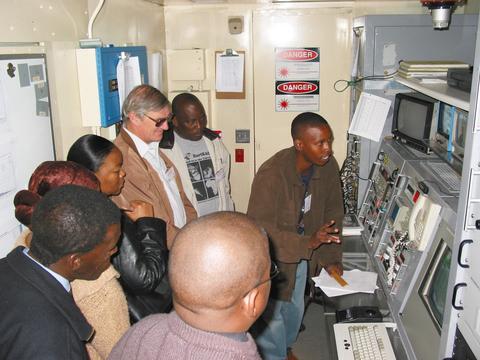
Sam Tshefu is one of the SLR operators, and is seen here describing how he tracks the satellites. Sam started work as a gardener at HartRAO, but his potential was soon recognised, and this led to his present position.
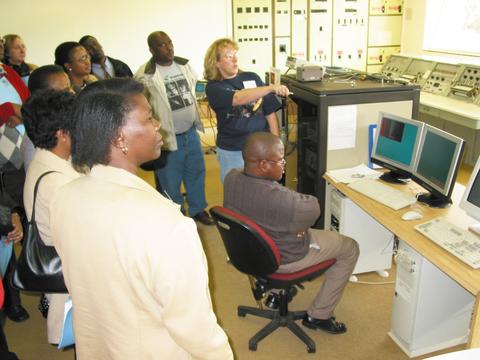
Programmer and astronomy PhD student Sarah Buchner described how the radio telescope operates under computer control. She was followed by recent PhD graduate Sharmila Goedhart, who talked about her her studies in the field of high-mass star formation, or 'star birth'. Sarah took over again to describe research into pulsars, the collapsed remains left behind after the 'death' of a massive star in a supernova explosion.
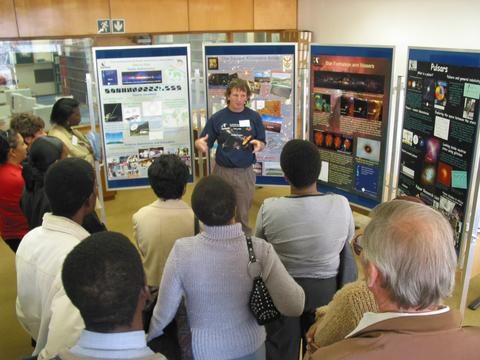
Observatory Director Justin Jonas talked about taking radio astronomy into the future, with the international 'Square Kilometre Array' collaboration. He noted that South Africa is both bidding to be the host country for the SKA and using it as a technology development thrust.
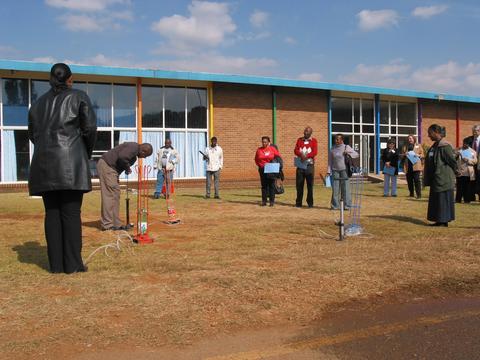
The Observatory's Science Awareness Programme has brought many thousands of learners to the observatory, where they engage with science in a very hands-on way. The visitors had a chance to do the same, in this case by launching plastic cold drink bottles using water and air compressed with a little muscle power as fuel. Staff educator Daphne Kedibone Lekgwathi, seen on the right in a green jacket, guided the visitors through the experience.
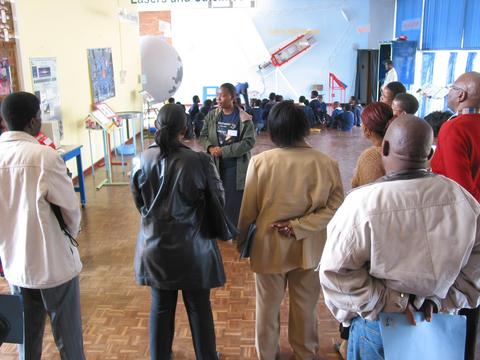
Inside the Visitors Centre, a group of learners from a school in Soweto was discovering the science spinning objects, using a turntable. Here Daphne describes the various outreach activities while in the background trainee educator Sheila Padi gives the learners a feel for angular momentum.
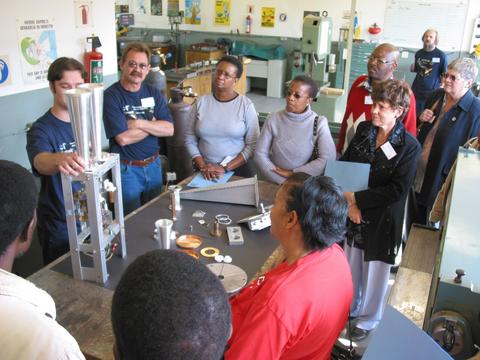
The Observatory relies on a team of support staff in three workshops to build and maintain much of the equipment. Here in the mechanical workshop, B Tech student Japie Greef shows a microwave receiver system for the radio telescope that was built by Andre van der Merwe, seen with arms folded just to his right.
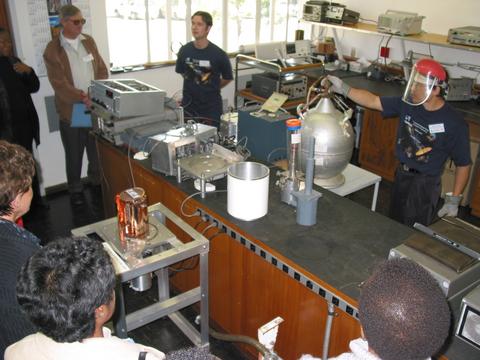
The radio receivers are built and serviced in the microwave laboratory. Here technician Roland Huang, his faced shielded by a protective helmet, demonstrates how liquid nitrogen (at -196° Celcius, or 77 Kelvins) is used to calibrate the radio receivers. In the foreground is the receiver for 3.5 cm wavelength, removed for servicing after nearly five years of operation. The copper heat shield stands out. This is normally inside a vacuum jacket as the receiver is cooled down to -257° Celcius, or 16 Kelvins, to minimise its internal noise.

Various electronic devices are continually being designed and built in the electronics workshop. A complete backup of the telescope control electronics is kept in the workshop as a spare and for development work. Here this backup is being used by engineer Keith Jones to run the new controller of the tilt actuator for the secondary mirror of the radio telescope - simulated here by a large lead weight!
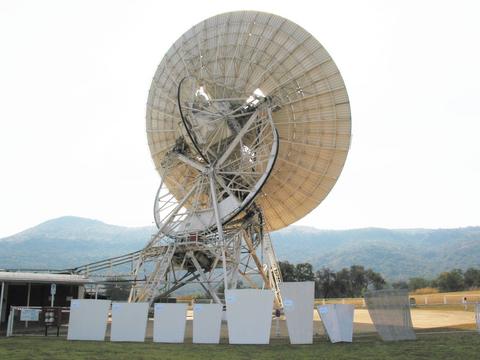
During the visit, the radio telescope was operating as part of the European VLBI Network, creating a 'virtual telescope' two thirds of the size of the Earth. In the foreground is a display of one of each type of new panel for the main surface of the telescope, plus, on the right, the 'skin' of one of the old panels. There are seven rings of panels, for a total of 252 panels. The in-house production of the new panels was recently completed, as part of the latest upgrade of the telescope.
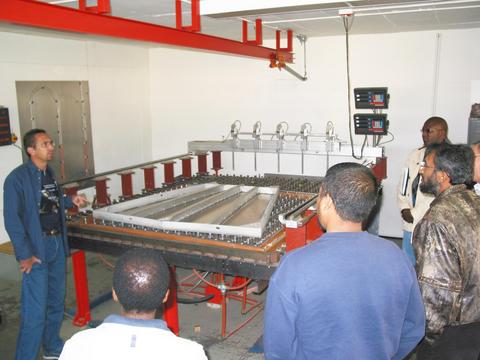
Surface upgrade technician Jacques Grobler explains how the new panels were made, on a jig comprising an adjustable 'bed of bolts'.